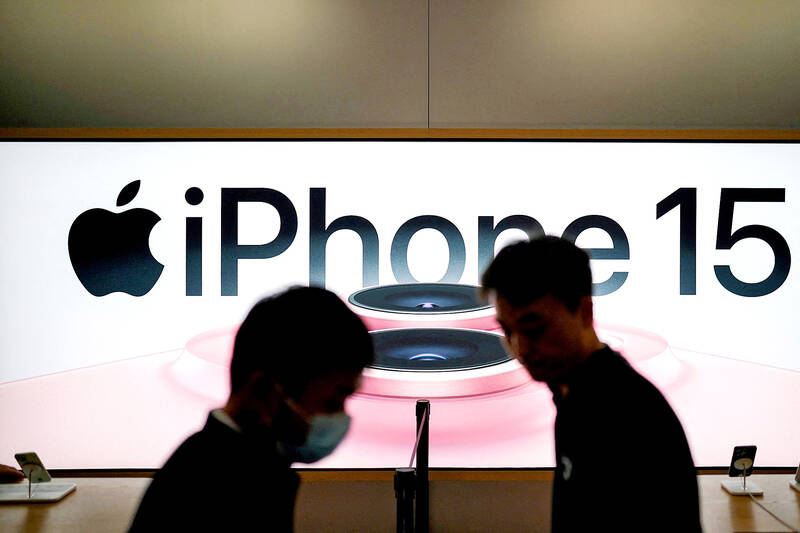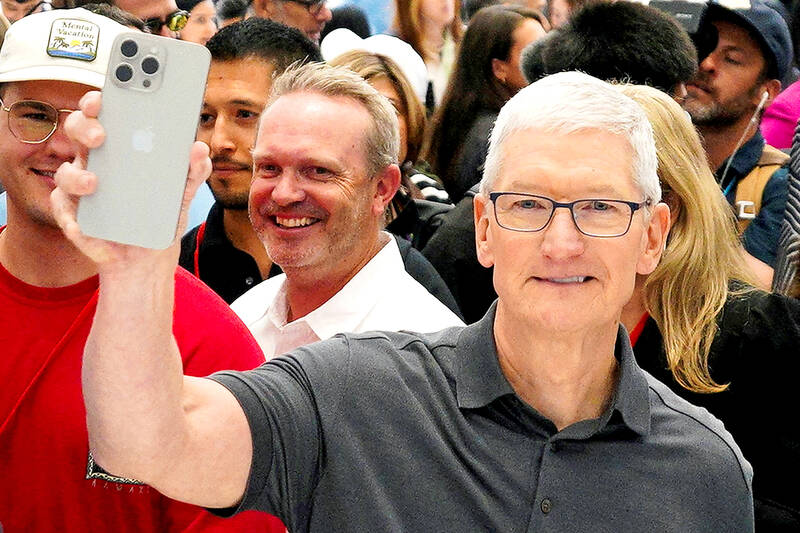Apple’s iPhone 15 Pro might be overshadowed by its larger maxed-out sibling this year, but the cheaper of the “pro” iPhones still has one big advantage: a more pocketable size.
The 15 Pro has had a £100 (US$123)price cut over last year’s model starting at £999, widening the gulf between it and the £1,199 Pro Max. It still isn’t cheap, but is roughly in line with competing high-end phones.
As with the Pro Max, the 15 Pro swaps its predecessor’s stainless steel sides for titanium, saving 19g and significantly changing the feel of it. It is light, easy to handle and pocket, which is immediately noticeable if you’re coming from any of Apple’s older Pro phones.

Photo: Reuters
The 6.1in OLED screen is genuinely fantastic and better than you’d get on similarly sized devices, reaching a very bright 2,000nit peak when outdoors for easy viewing in bright sunlight. The Face ID system within the dynamic island at the top of the screen remains one of Apple’s killer features.
The new action button replaces the mute switch from previous iPhones. It can be set to launch various apps or tasks such as the torch or switching focus modes instead of muting the phone.
SPECIFICATIONS

Photo: Reuters
Screen: 6.1in Super Retina XDR (OLED) (460ppi)
Processor: Apple A17 Pro
RAM: 8GB
Storage: 128, 256, 512GB or 1TB
Operating system: iOS 17
Camera: 48MP main, 12MP UW and 12MP 3x zoom, 12MP front-facing camera
Connectivity: 5G, wifi 6E, NFC, Bluetooth 5.3, Thread, USB-C, Satellite, UWB and GNSS
Water resistance: IP68 (6 metres for 30 mins)
Dimensions: 146.6 x 70.6 x 8.25mm
Weight: 187g
A17 Pro chip and a USB-C port
Another significant upgrade is the switch from Lightning to USB-C, which for most people coming from older iPhones will simply mean replacing the cable, one of which is included in the box. Those with accessories may need to buy adaptors, but the switch means the 15 Pro can charge from practically any charger and USB-C cable used by all Android devices, PCs and Macs, iPads and other tablets — you no longer need to buy special Apple cables.
It also opens up the possibility to connect myriad accessories, including display cables, SD card readers, audio adapters, game controllers such as the Backbone One and many other USB-C equipped products.
The new A17 Pro chip is rapid and supports advanced ray tracing graphics similar to consoles for the first time for even better gaming. It is fast now and will stay fast for many years to come.
Battery life is very good for this size of phone, lasting about 38 hours between charges with the screen actively used for five hours. On the heaviest of days, spent mostly on 5G using maps and shooting photos, the battery still managed to last about 28 hours. That means you will have to charge it nightly but it should always make it easily through the day.
SUSTAINABILITY
Apple says the battery should last in excess of 500 full-charge cycles with at least 80 percent of its original capacity and can be replaced for £95. Out-of-warranty screen repairs cost £349. The 15 Pro adopts the same internal repair-friendly design introduced with the iPhone 14, but the phone was awarded only four out of 10 for repairability by the specialists iFixit because of Apple’s use of software to restrict third-party repair.
It contains recycled aluminum, cobalt, copper, gold, plastic, rare earth elements, tin and tungsten. The company breaks down the phone’s environmental impact in its report. Apple offers trade-in and free recycling schemes, including for non-Apple products.
CAMERA
The camera on the 15 Pro is the same as the 15 Pro Max apart from the telephoto camera, which only has a 3x optical zoom similar to previous models.
The main camera captures 24-megapixel photos by default, can shoot at three different focal lengths (24, 28 or 35mm) and capture full 48MP photos in either ProRaw or HEIF formats, which will please keen photographers. The camera also has the useful 2x zoom mode from last year, while all three cameras also now automatically capture portrait photos without needing a dedicated mode, which is a much better system.
Overall, the 15 Pro’s ultrawide, main and 3x telephoto cameras are unrivalled at this size of phone, producing really great images in most conditions with very little work required. It’s just shame it lacks the 5x optical zoom camera of the Pro Max.
VERDICT
For the first time in a couple of years buyers of Apple’s top smartphones have a more difficult decision to make on their next upgrade. The iPhone 15 Pro is the best smaller phone on the market by some margin, but it no longer has the best camera on an iPhone.
Most of the hardware is the same, but it lacks the 5x optical zoom, which made such a meaningful upgrade to the 15 Pro Max. The smaller 15 Pro is still a significant improvement on previous 6.1in iPhone Pros, now noticeably lighter, with the benefits of USB-C and the handy action button.
It has slightly shorter battery life than the Max, but the smaller, lighter and more comfortable to hold design may be worth it. As may the pound saving, which is significant despite still costing the best part of a grand.
Pros: lighter and easier to hold, great cameras, fantastic screen, great size, USB-C, action button, good battery life, top performance, long software support, Face ID.
Cons: expensive, only 3x not 5x optical zoom, more repairable design restricted by software locks.

US President Donald Trump may have hoped for an impromptu talk with his old friend Kim Jong-un during a recent trip to Asia, but analysts say the increasingly emboldened North Korean despot had few good reasons to join the photo-op. Trump sent repeated overtures to Kim during his barnstorming tour of Asia, saying he was “100 percent” open to a meeting and even bucking decades of US policy by conceding that North Korea was “sort of a nuclear power.” But Pyongyang kept mum on the invitation, instead firing off missiles and sending its foreign minister to Russia and Belarus, with whom it

When Taiwan was battered by storms this summer, the only crumb of comfort I could take was knowing that some advice I’d drafted several weeks earlier had been correct. Regarding the Southern Cross-Island Highway (南橫公路), a spectacular high-elevation route connecting Taiwan’s southwest with the country’s southeast, I’d written: “The precarious existence of this road cannot be overstated; those hoping to drive or ride all the way across should have a backup plan.” As this article was going to press, the middle section of the highway, between Meishankou (梅山口) in Kaohsiung and Siangyang (向陽) in Taitung County, was still closed to outsiders

Many people noticed the flood of pro-China propaganda across a number of venues in recent weeks that looks like a coordinated assault on US Taiwan policy. It does look like an effort intended to influence the US before the meeting between US President Donald Trump and Chinese dictator Xi Jinping (習近平) over the weekend. Jennifer Kavanagh’s piece in the New York Times in September appears to be the opening strike of the current campaign. She followed up last week in the Lowy Interpreter, blaming the US for causing the PRC to escalate in the Philippines and Taiwan, saying that as

The Chinese Communist Party (CCP) has a dystopian, radical and dangerous conception of itself. Few are aware of this very fundamental difference between how they view power and how the rest of the world does. Even those of us who have lived in China sometimes fall back into the trap of viewing it through the lens of the power relationships common throughout the rest of the world, instead of understanding the CCP as it conceives of itself. Broadly speaking, the concepts of the people, race, culture, civilization, nation, government and religion are separate, though often overlapping and intertwined. A government